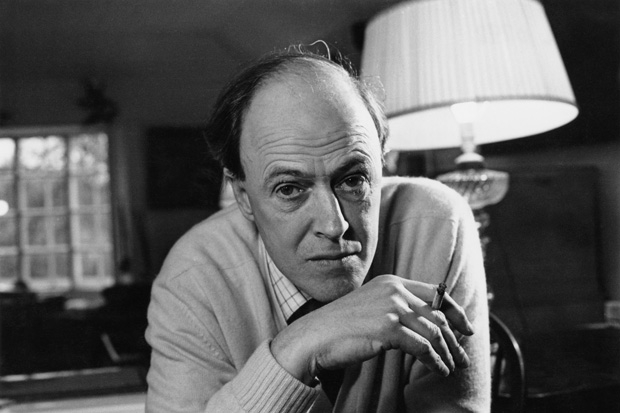Are writers born or made? The answer, by the end of Love from Boy — a selection of Roald Dahl’s letters to his mother drawn from the 40 years of correspondence they kept up, lovingly edited and deftly commented upon by his biographer Donald Sturrock — is surely that they are both.
Even as a 12-year-old, regaling her with tales of derring-do at Repton, the economy and vivid turn of phrase are evident that would characterise both his grand guignol short stories for adults and the children’s books for which he eventually became both loved and lauded. Out ice-skating, ‘I had eight chaps pulling me with a long rope at a terrific lick and I sat down in the middle of it. My bottom is all blue now.’ A year later, a maths teacher is described as ‘A short man with a face like a field elderberry, and…a voice like a frog, no chest and a pot-belly, no doubt a species of Rumble-hound.’
Sturrock thinks that Dahl’s mother, Sofie Magdelene (widowed when Roald was four), was the perfect reader for him. Unsentimental, unshockable, pragmatic and non-judgmental, loving (and beloved), she was someone with whom he wanted to be fully in touch and whom he wanted to entertain. Their relationship was governed by genuine love and friendship, not social convention, and this was surely the greatest blessing. If you’re free to be yourself, you are freer to hone your craft.
You can see much of the man and the writer in even the earliest letters. The wide-ranging curiosity and practical bent that would eventually result in his extraordinary co-invention of a new drainage valve for hydrocephalic children can be seen in the diagrams he draws for his mother (from scouting techniques to a Heath-Robinsonesque mousetrap he designs at school) and even in an early request for the Children’s Newspaper rather than the less informative Bubbles periodical for children to be sent him.
The love of animals, the eye for an anecdote (accounts of school floods, fires and encounters with bulls on field days are all delivered with relish), the savouring of eccentricities and physical horrors (in his drinking club a fat man sits ‘flowing over his chair like a hot jellyfish’), and the joyous interest in bums (‘I had a grand shit in a petrol tin this morning’) that would later appal children’s literary critics are all present and correct from the off. So too is the absolute confidence. At 16 he was dictating the arguments his mother should make to insurers of his motorbike — a harbinger of the man who gathered admirers and detractors throughout his life for his insistence that the world should always bend to his will.
To say that he could be himself in his letters home to Sofie Magdelene is not to say that he told her everything. As Sturrock’s succinct introductions giving the background to the periods covered by each of the book’s seven sections (and epilogue) show, there were always things he hid from her, be it his hatred of boarding and bullying, his friend’s expulsion for homosexuality or the severity of his near fatal wartime injuries, caused by a forced landing in the Libyan desert. ‘The ear, nose and throat man pulled my nose out of the back of my head and shaped it and now it looks just as before.’
Invalided out of the RAF, he became a diplomat in the US, and soon after a spy, mixing in grand literary and political circles. The letters are strewn with famous names: lunch with the Roosevelts, dinner with Noël Coward and Ernest Hemingway and cocktails with film stars (he would soon marry one — Patricia Neal — and go on to have five children with her). He was launched effortlessly into a writing career by C.S. Forester, who recognised that the ‘notes’ Dahl put down for him about his plane crash were complete unto themselves and arranged for them to be published as a short story under Dahl’s name in the Saturday Evening Post.
After that, much of his comic and fictive energy is siphoned off and the letters become more sedate, though never dull. Sofie Magdelene kept them all, in neat bundles tied with green tape, and they were restored to her Boy after her death in 1967. He kept none of hers. ‘I just don’t think he had a desire to keep them. So they were read and then binned. Unsentimental, certainly, possibly cold,’ said Sturrock when I emailed to ask whether he knew why.
But she is there, his correspondent, his foil, soundingboard and first reader, nevertheless, in every unselfconscious line penned by a child and man as certain of his place in her heart as he was of his place in the world, constrained only by the desire not to worry her. Much love from Boy.






Comments